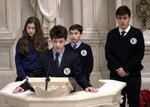

Last issue, this space featured a report about a Mass at St. Paul the Apostle Church in Manhattan marking the bicentennial of the birth of Father Isaac Hecker, C.S.P., the founder of the Paulist Fathers. This time, it features another marked anniversary—the opening of the bicentennial year of St. Elizabeth Ann Seton, the founder of the Sisters of Charity and the first American-born saint.
Her feast day, Jan. 4, was observed with a Vigil Mass for the Epiphany celebrated by Cardinal Dolan at St. Peter’s Church on Barclay Street in lower Manhattan. St. Elizabeth Ann Seton died on that date in 1821 at age 46 in Emmitsburg, Md., where she established the first American congregation of religious sisters and the first Catholic girls’ school in the United States.
There will be many celebrations as her 200th anniversary nears, in Emmitsburg, and in other dioceses in the United States where her sisters still serve, including New York.
In 1817, Mother Seton, as she was known, sent three sisters to New York to staff the Roman Catholic Orphan Asylum on Prince and Mott streets in lower Manhattan, which was in its early stages. Laymen had approached Bishop John Connolly to ask him to request that Sister Elizabeth Ann Seton send her sisters to New York to serve the orphanage.
So began the work of the Sisters of Charity here, where it continues more than 200 years later, said Sister Regina Bechtle, S.C., who co-edited “The Collected Writings of St. Elizabeth Ann Seton,” published by New City Press.
Sister Regina said she often pauses to consider the differences encountered by the first three Sisters of Charity, Rose White, Cecilia O’Conway and Felicité Brady, when they arrived in New York. The dirt, noise and craziness of early 19th century New York City must have been a shock compared to the rural hills of Maryland, she said.
“Talk about coming where you are led, where you are sent, and doing what is before you to do,” Sister Regina said.
In 1810, St. Joseph’s Academy and St. Joseph’s Free School both opened in Emmitsburg. The funds the academy earned for the sisters’ instruction paid the way for poorer children to attend the free school. The successful pattern was repeated at Sisters of Charity schools across the country, Sister Regina said, as requests flowed in for the sisters’ Catholic education.
Sister Regina was asked to consider why St. Elizabeth Ann Seton remains such as enduring figure in the Catholic imagination even now, two centuries later.
“Her way of seeking and doing what she believed to be God’s will,” she responded. “Trying to align her life with where God was leading her was one of the driving passions of her life.”
St. Elizabeth Ann Seton’s story began in New York, where she was born in 1774. Elizabeth Ann Bayley was born into a prominent New York City family. At age 19, she married a wealthy businessman, William Magee Seton, and they soon moved into a residence on Wall Street. They were members of the Episcopal Church. The couple had five children. Her husband succumbed to tuberculosis in 1803.
Elizabeth was introduced to the Catholic faith by the families of her husband’s Italian business partners. In 1805, she was received into the Catholic Church at St. Peter’s Church on Barclay Street. Father Jarlath Quinn, the pastor of St. Peter’s, in remarks at the Jan. 4 Mass, said the parish was proud to honor St. Elizabeth’s entrance into the Catholic Church as part of “the great tradition in the Church of converts to the Catholic faith.”
During his homily at the Jan. 4 Mass, Cardinal Dolan recited a list of holy Catholic people who, like St. Elizabeth Ann Seton, prayed at St. Peter’s. They included Venerable Pierre Toussaint, the former slave in Haiti who became a paragon of charity in New York; Venerable Father Felix Varela, a native of Cuba who served as vicar general of the then-Diocese of New York; and Servant of God Dorothy Day, a social justice activist and co-founder of the Catholic Worker movement.
It’s like that in New York, especially at a church like St. Peter’s, which has been around since 1785. Today, the parish is called St. Peter’s-Our Lady of the Rosary, reflecting the 2015 merger with Our Lady of the Rosary on State Street, which houses a shrine to St. Elizabeth Ann Seton.
If you’ve never seen St. Peter’s for yourself, I highly encourage you to make a visit at some point during this bicentennial year the marking St. Elizabeth Ann Seton’s entry into eternal life. You will be astounded by the church’s beauty, and by the New York Church history within its walls.